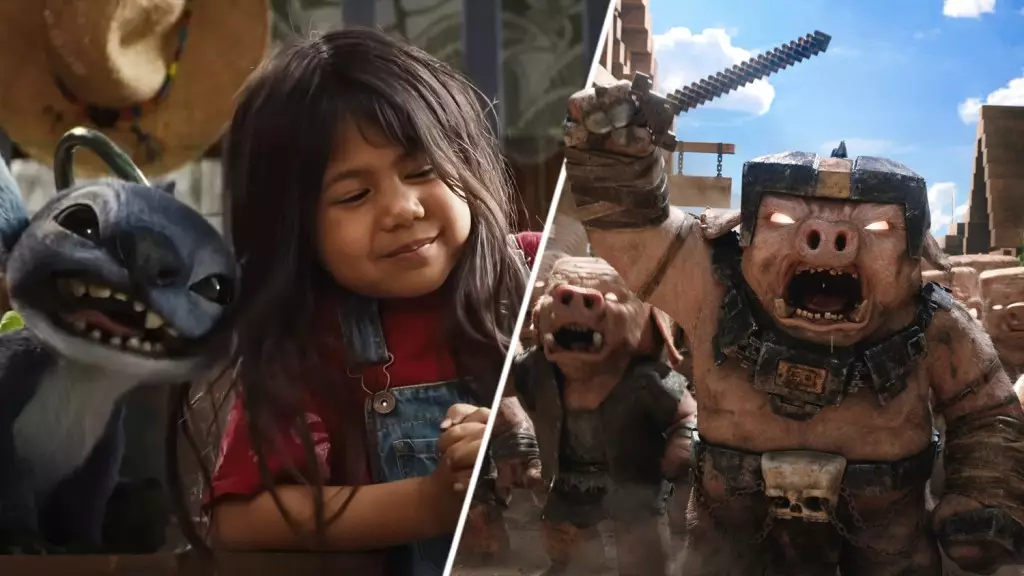In an industry still grappling with the repercussions of COVID-19 and ongoing strikes, Disney’s recent success with Lilo & Stitch demonstrates an undeniable shift in audience preferences. Traditionally, blockbuster contenders have leaned heavily on star power, high-octane franchises, or cutting-edge CGI to drive sales. Yet, here we observe a charming, somewhat retro property defying those norms, proving that nostalgia and beloved characters remain powerful enough to invigorate cinemas. Disney’s strategic pivot to capitalize on these feelings of familiarity and emotional connection reveals a savvy understanding of market dynamics: in uncertain times, consumers seek comfort and familiarity.
What’s especially compelling is how Lilo & Stitch, a film that originally underwhelmed at the box office in its 2002 release, has resurged as a cultural phenomenon. The live-action adaptation’s six-week run topping $403 million domestically — just behind the massive Minecraft Movie at $423.9 million — underscores how a well-studied blend of nostalgia, modern marketing, and timely release timing can outperform even the most hyped franchise entries. It is a testament to Disney’s refined ability to repackage its catalog in ways that resonate with both old fans and new generations, creating a hybrid appeal that feels both fresh and rooted in memory.
The importance of this development extends beyond Disney’s immediate profits. It signals that in a post-COVID box office, audience loyalty can still be cultivated via properties that evoke gentle nostalgia rather than relying solely on spectacle. This approach might be the blueprint for other studios desperate to regain their footing amid ongoing industry upheavals. The audience’s appetite for films like Lilo & Stitch, especially among women (62% demographic), reveals a lucrative niche that Hollywood rarely fully capitalizes on, yet which Disney is now tapping into with notable success.
Market Success: A Sign of Shifting Industry Priorities
The geographic distribution of Lilo & Stitch’s success illustrates a broader strategic insight: no longer are North American markets the sole focus of major studios. The film’s impressive performance across Latin America, Europe, and parts of Asia — with particular dominance in France, Mexico, and Brazil — is indicative of a savvy international distribution strategy. Countries with a strong affinity for Disney’s soft, family-friendly content are rapidly becoming the primary battleground for market share, especially as Western audiences become more discerning.
Additionally, its record-breaking domestic opening — the biggest four-day Memorial Day weekend ever for Disney — starkly contrasts with the industry’s previous hesitations regarding theatrical releases. The success of Lilo & Stitch, along with the Minecraft Movie, affirms that theatrical cinema remains an essential, profitable venue, provided the product resonates authentically. Disney’s confidence to produce a live-action version of a modestly performing animated film reflects a broader industry shift: established brands and characters, rooted in beloved narratives, can generate robust returns when executed thoughtfully.
What truly sets this apart is the recognition that these domestic and international gains are not merely fleeting blips. Lilo & Stitch’s cultural footprint extends beyond box office figures, evidenced by over 579 million hours streamed globally and retail sales soaring to $2.6 billion in just five years — a tenfold increase from 2019. This indicates that Disney’s gamble on nostalgia-driven franchises aligns with a larger trend of multimedia and merchandise convergence, which ultimately consolidates long-term brand loyalty and revenue streams.
Implications for Hollywood’s Future and the Need for Authentic Content
The Hollywood industry often claims it’s in a creative rut, overly reliant on sequels, reboots, and franchise fatigue. Yet, Lilo & Stitch’s success challenges this narrative, demonstrating that authentic storytelling combined with strategic branding can revitalise even the most modest properties. The focus on female audiences, especially with franchises like Moana 2 and How to Train Your Dragon, reveals a conscious effort to diversify storytelling and market segments — a move that more studios should emulate.
From a political perspective aligned with center-right liberalism, the message is clear: responsible capitalism within the entertainment industry can foster artistic innovation and economic growth when companies prioritize quality content and audience needs over fleeting trends. Disney’s ability to leverage its catalog responsibly, while expanding its retail and streaming dominance, underscores the importance of a balanced approach—merging tradition with modern enterprise.
Ultimately, the resurgence of Lilo & Stitch as a box office titan signals a significant reversal in industry confidence. It suggests that as long as studios listen to their audiences and adapt their marketing strategies effectively, there’s still a thriving future for theatrical films rooted in nostalgia, authenticity, and smart branding. Amidst ongoing upheaval, Disney’s latest success story demonstrates that classic characters and compelling storytelling remain the true currency of cinematic success in the 21st century.

